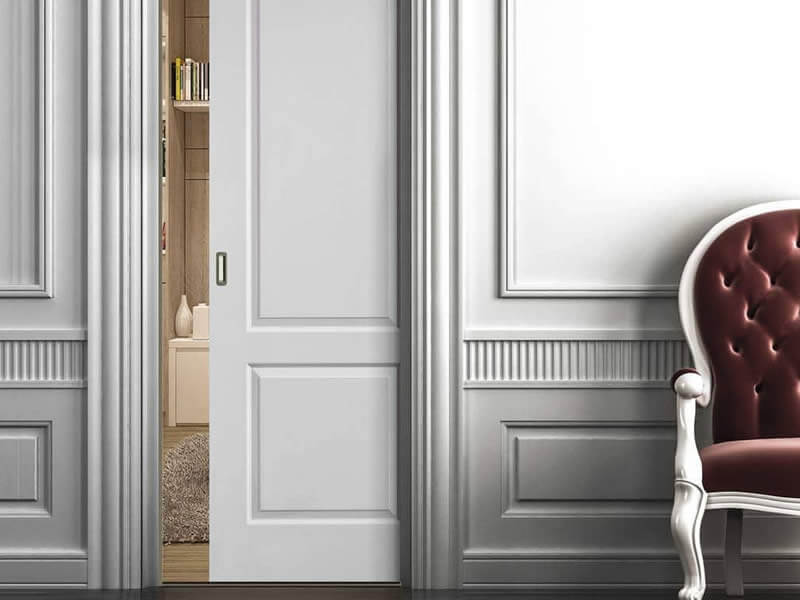Pocket Door Installation Cost
The installed cost of a pocket door, or sliding door as they are commonly called, is around $1,190 when you hire a local pro to handle the job and a single sliding pocket door is installed. For double pocket doors, expect the cost to be around $2,100. If you’re a handy homeowner, you could install the door yourself for around $250 – $550, depending on the door you choose and the tools you may need to purchase.
The contractor installed cost includes the pocket sliding door, all hardware and installation supplies, as well as the labor (5-7 hours) to install your new pocket door. The installer will also clean up the work area and assure you everything meets your satisfaction before considering the job complete.
Average Completed Costs

Overview of Installing a Pocket Door
Pocket doors are popular options for closets and pantries and to close off a laundry room or small half bath. You’ll often find them between the kitchen and a formal dining room where neither room could accommodate a hinged door.
But before we dive into a more detailed look at the cost factors involved in installing a new pocket door, let’s talk about the benefits of this type of door.
Why do people like pocket doors so much?
A pocket door is a type of door that slides into a “pocket” in the wall to open, rather than swinging out on a hinge, so the door disappears when open. This makes it a perfect option for tight spaces. Pocket doors are also popular for aesthetic reasons, as they offer an elegant alternative to a typical hinged door. Pocket doors are not used for the exterior of a home, so if you’re looking for a good door for an exterior entrance, check out our guide for Sliding Glass Door Costs.
This pocket door installation cost guide looks at the factors to consider when choosing a pocket door, and the costs involved in professional and DIY installation.
Some experienced homeowners choose to install their new pocket door themselves but cutting in the opening is a difficult DIY project! And if the wall you are considering for a pocket door has electric or plumbing lines in it, we highly recommend calling in a professional to complete your pocket door installation so that you can avoid injury and damage to your home.
Pocket Door Cost Factors
The list provided below is designed to help you think through the potential cost factors involved in installing a pocket door. Our goal is to equip you to make the best decisions for your lifestyle, so that you can have a successful project that brings value to your home.
Here are the cost factors to consider for installing a pocket door:
- Single or Double Pocket Door – Double pocket doors are also known as “French” pocket doors, because they open from the center and the doors slide into the right and left sides of the frame. Double pocket doors require twice the space and about twice the cost, for an average of about $1,200 – $2,500 for the whole project but can easily cost more.
- Pocket Door Size – Pocket doors come in many different sizes to fit whatever space a homeowner might have. In general, the larger the door, the more it will cost. The most common pocket door widths are between 24 and 48 inches, or between 2 and 4 feet wide. The larger a pocket door is, the more it will weigh, making the installation costs go up because the hardware inside the wall pocket needs to be stronger to accommodate the heavier door.
- Pocket Door Material – The available materials for pocket doors range in cost from budget-friendly to premium options. One of the most affordable pocket door options is to choose a hollow-core door. Hollow-core pocket doors are lightweight and inexpensive, making them a great choice for many homeowners. Another budget-friendly pocket door material is fiberglass. Fiberglass doors are strong and durable, and can be painted or given a wood grain texture depending on your preference. On the higher end of the cost range, you have glass and solid wood pocket doors. These options are elegant and can add value to your home, but they are also heavier and more prone to damage over time.
- New Construction vs. Existing Home – Installing a pocket door in a new construction home is easier and cheaper than installing a pocket door in an existing home. This is because with a new construction, you can plan around the pocket door and avoid complications like electrical or plumbing issues.
- Complicated Installation –The three main complications that homeowners encounter during a pocket door installation are electrical lines, plumbing pipes, and load-bearing walls.
Difficulties in installation usually involve:
- Electrical lines: If there is electrical work in the wall where you plan to install a pocket door, you will need to hire an electrician to safely divert the electrical lines, so that you can install the door. We always recommend hiring a professional for electrical work so as to avoid injury or hazard for you and your household.
- Plumbing pipes: The best way to be certain that you’re not at risk of drilling into a plumbing pipe is to call out a professional before you begin work to take a look at your wall. They will be able to tell you if there are plumbing pipes going through the wall that you need to avoid or move, and can give recommendations for the best way to do that.
- Load-bearing walls: In general, you can install a pocket door in a load-bearing wall. However, the installation is more complicated, and will most likely require some professional help. Don’t risk the structural integrity of your home! Call someone out to take a look at the place you want to put a pocket door before you begin the project.
Sliding Pocket Door Retail Costs
Cheap, hollow-core pocket doors start below $150. Quality 3-panel or 6-panel solid wood doors range from around $450 to $800. Glass pocket doors often top $1,000.
How much does a pocket door cost – just for the door and its frame/assembly?
Whether you’ll pay under $200 or over $1,000 depends on these factors.
- Door Material – As noted above, this is the main factor in pocket door price.
- Door Quality – This especially relates to the track. When possible, always choose the stronger, “heavy-duty” track and hardware option. It will cost more but deliver with many more years of smooth openings.
- Finished vs Unfinished – If you choose wood, a finished door, whether painted or stained, will cost more than bare wood. Going with an unfinished door and finishing it yourself saves around 15-25% depending on the door. But if you’re not going to DIY the finish, then the cost of a pre-finished door is less than the cost of an unfinished door plus paying a pro to finish it. However, if you’ve got a specific stain color or paint color in mind, getting a bare door and finishing – or paying to have it finished – might be your only choices.
- Type of Finish – While minor among pocket door cost factors, primer and paint costs less than premium stain and a clear sealcoat.
- Hardware – Pocket doors have a simple, recessed handle and latch. Still, price can range from “included” in the door to $25 to $100 to install different hardware.
- Etched or frosted glass – Glass doors allow visibility while blocking noise. If you choose detailed glass, cost will be higher than plain glass.
Permits, Inspection, Related Costs and Installation Time
Permits and Inspection Cost
$0 – $200 | In general, a permit is not required to install a pocket door unless a load-bearing wall is affected or if utilities must be moved.
Approximate Installation Time
- 1 – 2 days | A professional can cut a pocket door opening and install the frame, door, and hardware in 1 to 2 full days based on site factors. Home Advisor says the work takes about 6 hours, but in our experience, most jobs take longer.
Who Does the Installation?
You’ve got a few options:
- Window and door contractors – If you’re having a range of interior doors installed, then local Pella and Andersen showrooms, for example, are happy to sell you a package that includes the doors plus installation. This is usually your costliest option, but it might produce the best results and warranty on the installation.
- A contractor arranged by the “big box” store – Stores like the Home Depot and Lowes can sell you installation along with the door, and they provide the contractor. They’ll build in a little profit in order to provide you with this service – and they choose the contractor, not you. While this often works out fine, when it doesn’t it can be a hassle getting the seller or installer to take responsibility.
- A contractor, often a carpenter or handyman, that you select – This option usually costs the least because it gives you the chance to shop around for price and there’s no “middleman” getting a cut of the cost. And it allows you to “vet” your options by checking Google or Yelp reviews and making an educated decision.
New vs Existing Construction
Pocket door installation in existing construction is multiple times more complex – and expensive – than when the work is done during construction.
- New construction or during a major remodel – The door frame and track are easily built into the wall during construction or a remodel when the drywall is removed, and the space is left clear of wiring and plumbing. Load-bearing concerns are easily addressed during initial construction.
- Existing construction – If utilities need moving or a wall needs bracing because it is load-bearing, the cost climbs fast. At minimum, expect to have drywall work to do or pay for on both sides of the pocket that is created.
Related Projects
Here are several other common projects related to having a sliding pocket door installed at your home.
Are You a Pro Installer?
If so, head over to our Costimates Pro’s page, and help us make this page better and more accurate for both our visitors and your future customers.
DIY or Hire a Pro?
Installing a pocket door is at least a moderate DIY challenge for an experienced homeowner. And that’s if there aren’t complications with electrical or plumbing lines. In most cases of existing rather than new construction, the wall on both sides of the pocket will need to be opened up – drywall removed, for example. And then the existing full stud/jamb is removed, replaced by steel uprights or a split wood jamb that the thin pocket door can slide through. These materials often come as part of the pocket door frame assembly.
In short, it is a lot of work, and somewhat complicated too. Watch a few tutorial videos like this one to know what you’re up against before deciding DIY is a good option.
If you hire a carpenter or handyman for the work, expect labor costs to be $400 to $800. Homewyse puts it at $480 to $775, or an average of $567 according to DIY or Not, which is pretty accurate depending on job complexity.

 Steve Hansen, that's me, the Senior Editor of Costimates. (
Steve Hansen, that's me, the Senior Editor of Costimates. (